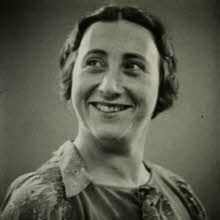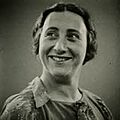Edith Frank facts for kids
Quick facts for kids
Edith Frank
|
|
|---|---|

Edith in 1939
|
|
| Born |
Edith Holländer
16 January 1900 |
| Died | 6 January 1945 (aged 44) Auschwitz-Birkenau, German-occupied Poland
|
| Known for | Mother of Anne and Margot Frank |
| Spouse(s) | |
| Children | |
| Relatives | Eugene Hollander (first-cousin) Michael Frank (father-in-law) Alice Betty Frank (mother-in-law) Robert Frank (brother-in-law) Herbert Frank (brother-in-law) Helene Frank (sister-in-law) Benjamin Hollander (paternal grandfather) Henriette Hollander (paternal aunt) |
Edith Frank (born Holländer; 16 January 1900 – 6 January 1945) was the mother of Holocaust diarist Anne Frank. She was also the mother of Anne's older sister, Margot. After her family was found hiding in Amsterdam during the Nazi occupation, she was sent to a Auschwitz-Birkenau concentration camp.
Contents
Edith Frank's Life Story
Early Years
Edith was the youngest of four children. She was born into a Jewish family in Aachen, Germany. Her father, Abraham Holländer, was a successful businessman. He was also active in the Jewish community of Aachen. Edith's mother was Rosa Holländer.
The Holländer family had lived in Amsterdam in the 1700s. They moved from the Netherlands to Germany around 1800. Edith's last name, Holländer, means "Dutchman" in German.
Edith had two older brothers, Julius and Walter. She also had an older sister, Bettina, who died at 16. Both Julius and Walter moved to the United States and survived the war. Edith's family was religious.
She went to the Evangelical Higher Girls' School. She finished school in 1916. After school, she worked for her family's company. In her free time, Edith loved to read. She also played tennis and went swimming. She had many friends.
Starting a Family
Edith met Otto Frank in 1924. They got married on 12 May 1925, which was Otto's 36th birthday. Their wedding was at the synagogue in Aachen.
They had two daughters born in Frankfurt. Margot was born on 16 February 1926. Anne was born on 12 June 1929. When Anne was born, the family lived in a rented house in Frankfurt.
Their daughters often played in the garden with other children. These children came from different backgrounds. Some were Catholic, some Protestant, and some Jewish. They were curious about each other's religious holidays.
The Frank family later moved to a different part of Frankfurt. This area was known as the Dichterviertel, or Poets' Quarter. Both of their houses still exist today.
In 1932, the Nazis' group called Sturmabteilung (SA) marched through Frankfurt. These "Brownshirts" wore swastika armbands. They sang hateful songs. Edith and Otto were very worried about this. They knew it would be hard to move to another country.
Moving to Amsterdam
Adolf Hitler became chancellor of Germany in 1933. This led to more antisemitism and unfair laws against Jewish people. Because of this, the Frank family had to move to Amsterdam in 1933.
In Amsterdam, Otto started a new company called Opekta. It sold spices and pectin. Edith found it hard to move to the Netherlands. Their living space was small. She also struggled to learn the new language.
She stayed in touch with her family and friends in Germany. But she also made new friends in Amsterdam. Many of them were also German refugees. Edith became active in Amsterdam's Liberal Jewish community. She often went to synagogue with Margot.
On Friday evenings, the Franks often visited German-Jewish friends for dinner. They also celebrated many Jewish holidays together. Edith was an open-minded woman. She raised her daughters in a modern way.
Her older brothers, Walter and Julius, moved to the United States after 1938. Edith's mother, Rosa Holländer-Stern, left Aachen in 1939. She joined the Frank family in Amsterdam. Rosa died there in January 1942.
Anne Frank's cousin, Bernhard ("Buddy") Elias, said that Edith never felt truly at home in Holland. He said she was "German" and missed Germany. She did not learn Dutch very well.
Hiding and Death
In 1940, the Nazis took over the Netherlands. They began to persecute the country's Jewish people. Edith's daughters were forced to leave their schools. Her husband, Otto Frank, had to give up his companies.
Otto made his businesses look "Aryan" to protect them. He gave control to his Dutch colleagues, Johannes Kleiman and Victor Kugler. These men later helped the family hide. On 6 July 1942, the Frank family went into hiding. They hid in a secret annex at Otto's company building.
The Frank family hid for two years. Four other people hid with them. These were their friends Hermann van Pels, his wife Auguste, and their son Peter. Also, Miep Gies's dentist, Fritz Pfeffer, joined them. Anne Frank wrote about this time in her diary. Her diary was published after her death.
In her diary, Anne often wrote about disagreements with her mother. She also wrote about her mother's sadness. But Anne also described her mother as understanding and loyal. She said her mother protected her daughters. On 2 January 1944, Anne wrote that her feelings about her mother had changed. She felt wiser and her mother was calmer.
The diary ended three days before they were found. Someone betrayed them, and they were arrested on 4 August 1944. Edith and the others were first held by the Gestapo. Then they were sent to the Westerbork transit camp. From there, they were sent to Auschwitz concentration camp on 3 September 1944. This was the last train from Westerbork to Auschwitz.
Edith and her daughters were separated from Otto when they arrived. They never saw him again. Edith tried to keep her children alive. Survivors said they were always together. On 30 October, Edith was separated from Anne and Margot. Edith was chosen for the gas chambers. Her daughters were sent to Bergen-Belsen.
Edith managed to escape to another part of the camp with a friend. She stayed there through the winter. Edith became very sick. She was taken to the sick barracks. She died from weakness and disease on 6 January 1945. This was three weeks before the Red Army freed the camp. It was also 10 days before her 45th birthday. Her daughters died about a month after her.
Anne's Diary and Her Mother
Otto Frank was the only one in his family to survive the Holocaust. He returned to Amsterdam in June 1945. One of the helpers, Miep Gies, gave him Anne's diary papers. She had saved parts of them, along with another secretary, Bep Voskuijl.
When Otto Frank decided to publish his daughter's diary, he edited it. He removed some of Anne's harsher comments about her mother. He did this out of respect for Edith and the others in the Secret Annex. However, Anne's early writings about her mother were still shown in plays and movies.
People who knew Edith described her differently. They remembered her as a modest and quiet woman. She tried to treat her daughters as equals.
In 1999, new pages from Anne's diary were found. These pages showed that Anne realized something important. She saw that Edith loved Otto very much. But Otto, while devoted, was not "in love" with her. This understanding helped Anne feel more empathy for her mother.
Bloeme Evers-Emden, a survivor from Auschwitz, remembered Edith and her daughters. She said, "they were always together, mother and daughters. It is certain that they gave each other a great deal of support." All the difficult feelings a teenager might have for her mother were no longer important.
In 1968, Otto Frank wrote about his wife in his memoirs. He said she was "truly an excellent mother, who put her children above all else."
Images for kids
See also
 In Spanish: Edith Frank para niños
In Spanish: Edith Frank para niños




